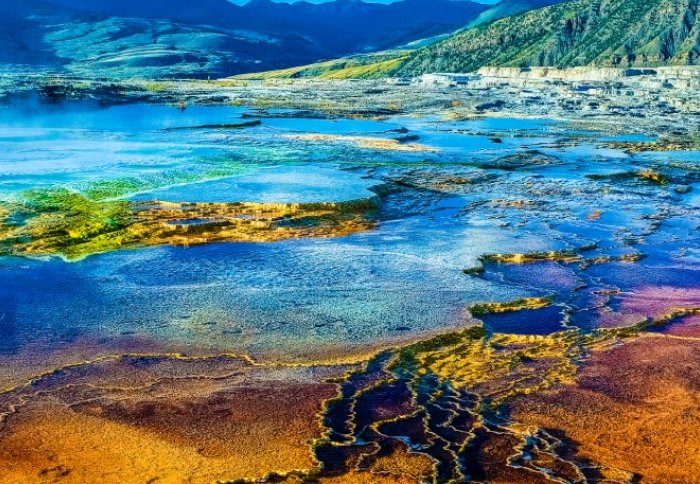Imperial scientist explains how oxygen triggered Earth's first mass extinction
by Colin Smith

An Imperial professor explains the origins of oxygen on early Earth and how he is trying to unravel the secrets of this period of great change.
Professor Dominik Weiss, from Imperial’s Department of Earth Science and Engineering, and his colleagues have developed a new technique. It enables them analyse the ratios of different isotopes of copper, buried in shale rock deposits. This pioneering technique is helping them to learn more about how the rise of oxygen changed the chemistry of Earth’s oceans forever.
Professor Weiss talks to Colin Smith about the Great Oxidation Event, which happened billions of years ago and sparked what is believed to be the first ever mass extinction of life on Earth, setting the stage for the expansion of oxygen-based life.
What did early Earth look like around two billion years ago?
That is a good and difficult question, but in essence we know that there was no complex life present on Earth before about 580 million years ago. However, there were simple bacteria and the atmosphere was full of methane. Radiation from the sun was fierce and there was little protection against ultraviolet radiation. Volcanoes spouted methane and hydrogen sulphide, which would have reacted with any early oxygen. The Earth's crust had at this time cooled enough that early continents were beginning to form.
What is the Great Oxidation Event?
The Great Oxidation Event, GOE, is one of the most important events during this early history of Earth. It marks the period of time when oxygen first appeared permanently in the Earth's atmosphere and oceans. We believe it was being generated by simple single-celled creatures through their biological activities. This in turn had a profound impact on the chemistry of the Earth– its atmosphere, its oceans, on land and in the evolution of oxygen-based life.
When and how did it happen?
Between 3.85 and 2.45 billion years ago there was practically no oxygen in the atmosphere. Geological and geochemical evidence suggest that this major change happened approximately between 2.4 to 2.3 billion years ago. From 2.45 to 2.3 billion years ago oxygen was produced by simple organisms, but it was absorbed in the oceans and seabed rock. Finally, between 750 million to 452 million years ago oxygen started to gas out of the oceans. The levels gradually rose over millions of years to reach present day levels.
Why is this period in Earth’s early history so important to know more about?
The permanent introduction of oxygen into the atmosphere fundamentally changed the ecology of the planet. The first impact was on anaerobic organisms, which didn’t need oxygen to survive. The rise in oxygen levels was poisonous to them and led to most them becoming extinct. Some managed to survive, but they retreated deep into the subsurface where there is no oxygen. This was one of the first mass extinctions in the history of our planet, and it was also the catalyst for the evolution of oxygen-based life – us!
If the GOE happened billions of years ago, how can we learn more about this important period of time?
Weathering of the Earth’s crust, when minerals in rocks are exposed to oxygen, first began during the GOE. This chemical change in the minerals is locked in the rocks and provides us with a geological record and a way to roughly determine oxygen in the Earth’s early atmosphere and oceans.
In our new study we studied isotope ratios of copper in rocks. Billions of years ago the weathering of rocks on land caused copper to be washed out to sea. It reacted with iron particles on the sea floor. The isotopic ratios in the copper act like a proxy, telling us more about their reaction and helping us to peer into the past and gauge what the oxygen levels may have been like on the ocean floor. Together with my colleague Dr Ernest Chi Fru, the lead scientist of the project from Stockholm University, we are pioneering the analysis of copper isotope proxies to understand the GOE.
What did your new method tell you about the Great Oxidation Event?
We now can distinguish more clearly the chemical conditions of Earth’s early oceans. In particular, it helped us to see the levels of iron versus the level of sulphide chemicals in the oceans. For example, if more iron oxides were formed it tells us that oxygen levels were high and similar to conditions in the ocean now. More sulphide tells us that the early chemistry of the ocean was still very oxygen-poor. By analysing the copper we found that the first increase in atmospheric oxygen ocean level was protracted, lasting at least 130 million years. This is much slower than scientists had previously supposed.
How are you going to apply this technique in the future? What are you planning to learn more about?
We have now shown that this method works, across the period when Earth’s atmosphere first became oxygen-rich. However, we know that throughout Earth’s history there has been several changes in marine oxygen content that orchestrated some of the other major extinction events. We now hope to use this method to understand more about these.
Article text (excluding photos or graphics) © Imperial College London.
Photos and graphics subject to third party copyright used with permission or © Imperial College London.
Reporter
Colin Smith
Communications and Public Affairs